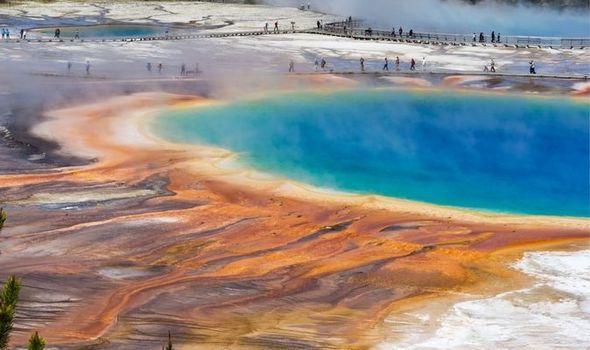The Yellowstone supervolcano located in Wyoming may look beautiful, but it packs a powerful punch. Researchers believe it has the potential for one of the deadliest eruptions in human history, although thankfully for our planet the supervolcano has not erupted in 70,000 years. But some scientists fear the sleeping giant could one day awake, and it will unleash global chaos when it does.
Pressure beneath Yellowstone mounts over hundreds of thousands of years.
Heat rising from deep beneath the volcano would begin to rise, and melt the rock just below the ground’s surface.
As the heat rises from the core, it would create a mixture of magma, rocks, vapour, carbon dioxide and other gases.
If the volcano were to blow, the surrounding states of Montana and Idaho would be covered in volcanic magma and ash.
The blast would spread a three metre-thick layer of magma across 1,000 miles (1,600 kilometres).
This would mean rescuers would struggle to reach the blast sight, putting more and more civilians at risk.
However, the eruption would just be the tip of the iceberg, with a ‘nuclear winter’ likely to follow.
A nuclear winter is when so much ash and debris from Earth would be ploughed into the atmosphere.
This would cause a climate shift to ensue as the volcano would spew massive amounts of sulphur dioxide into the atmosphere, which can form a sulphur aerosol that reflects and absorbs sunlight.
Ultimately, this would cause temperatures to fall across the planet, which can lead to the lack of ability to grow crops and ultimately widespread famine.
However, there is no sign that the supervolcano will erupt any time soon, and one geologist has stated there will be plenty of warning if it were about to erupt.
Volcanologist Dr Erik Klemetti of Denison University wrote in a piece for the Big Think: “Yellowstone is pretty calm as giant caldera systems go.
“We have such a small record of the behaviour of a ‘restless caldera’ that this inflation at Yellowstone could very easily fall into the realm of normal, non-eruption-causing behaviour.
“And if you ever worry, Yellowstone is also well-wired to see all the real time data, including earthquakes in the region and in the park, temperatures of hot springs, webcams, deformation within the caldera and hydrologic changes in the area.
“You would expect that if Yellowstone were headed towards an eruption, we would see lots of rapid inflation, lots of constant seismicity that gets shallower through time, a change in the temperature/composition of the hydrothermal systems and possibly even cracks forming in the land around the caldera.
“In other words, there will be lots of signs.”






